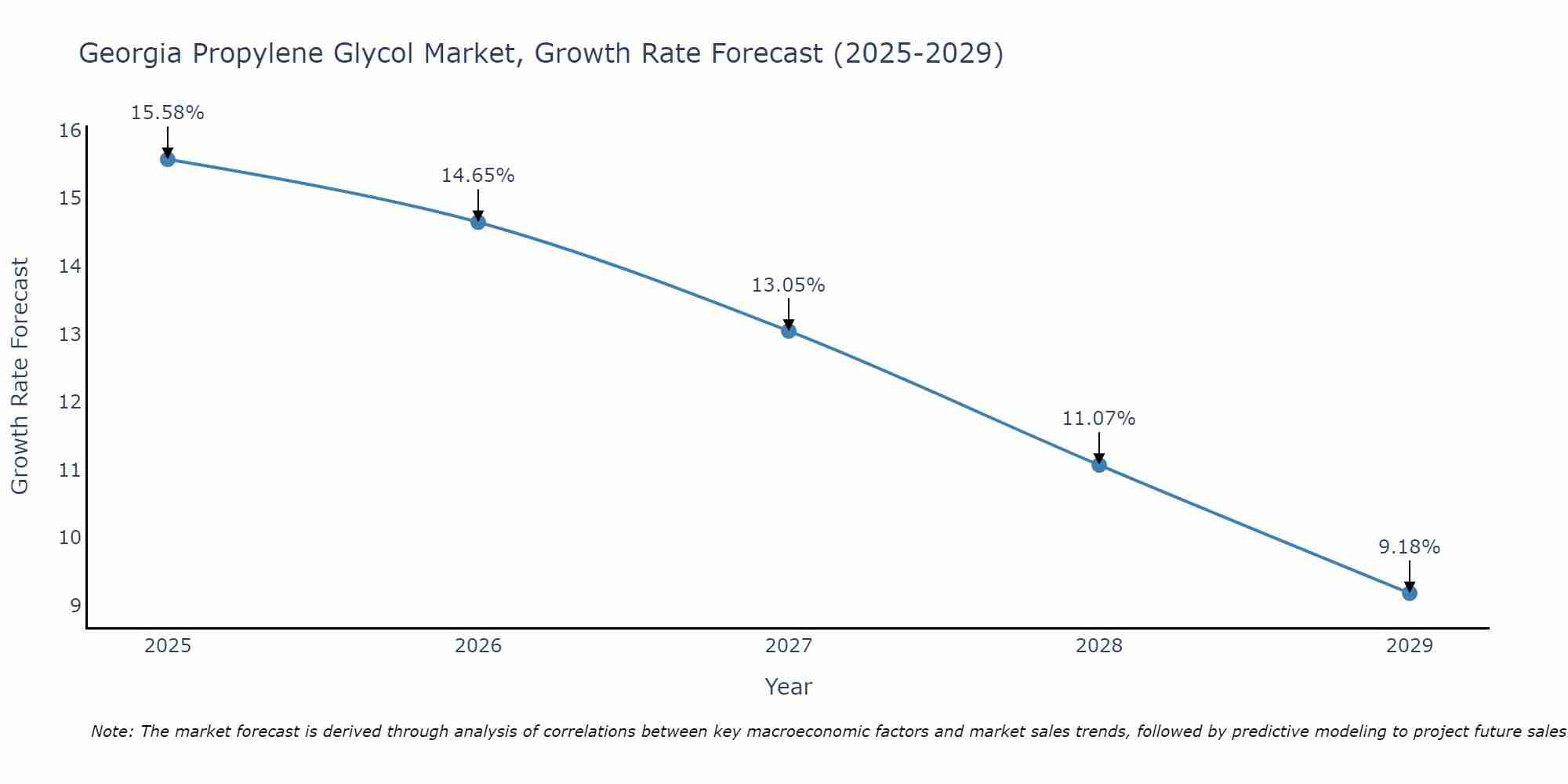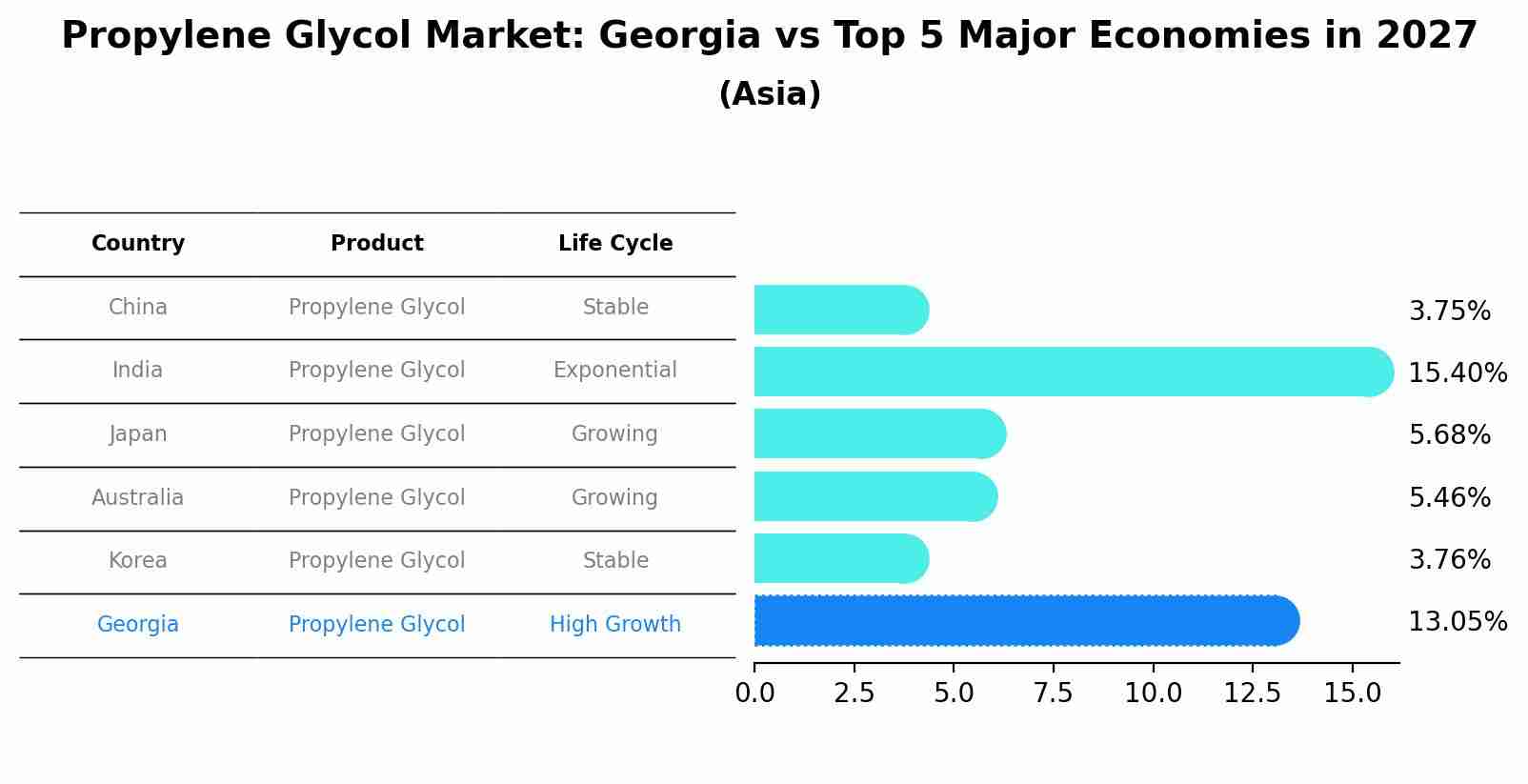Georgia Propylene Glycol Market (2025-2031) Outlook | Revenue, Trends, Companies, Analysis, Value, Share, Size, Growth, Forecast & Industry
| Product Code: ETC416936 | Publication Date: Oct 2022 | Updated Date: Aug 2025 | Product Type: Market Research Report | |
| Publisher: 6Wresearch | Author: Ravi Bhandari | No. of Pages: 75 | No. of Figures: 35 | No. of Tables: 20 |
Georgia Propylene Glycol Market Size Growth Rate
The Georgia Propylene Glycol Market could see a tapering of growth rates over 2025 to 2029. Starting high at 15.58% in 2025, the market steadily declines to 9.18% by 2029.

Propylene Glycol Market: Georgia vs Top 5 Major Economies in 2027 (Asia)
By 2027, Georgia's Propylene Glycol market is forecasted to achieve a high growth rate of 13.05%, with China leading the Asia region, followed by India, Japan, Australia and South Korea.

Georgia Propylene Glycol Market Overview
The Georgia propylene glycol market is experiencing steady growth fueled by the demand for propylene glycol as a versatile solvent, antifreeze, and ingredient in various industrial and consumer products. Propylene glycol is a colorless, odorless liquid with properties such as low toxicity, high stability, and water solubility, making it suitable for applications in pharmaceuticals, cosmetics, food and beverage, and automotive industries. With increasing consumer awareness of product safety and sustainability, manufacturers in Georgia are incorporating propylene glycol into formulations for personal care products, food additives, and industrial fluids, driving market expansion and adoption of propylene glycol-based solutions in the region.
Drivers of the market
The propylene glycol market in Georgia is experiencing significant growth driven by several key factors. One of the primary drivers is the widespread use of propylene glycol as a versatile chemical compound with applications across various industries such as pharmaceuticals, food and beverage, cosmetics, and automotive. With its properties as a solvent, humectant, and stabilizer, propylene glycol is utilized in numerous products and processes, including pharmaceutical formulations, food additives, personal care products, antifreeze solutions, and hydraulic fluids. Additionally, the expansion of end-use industries and the growing demand for environmentally friendly and biodegradable alternatives are driving market growth by creating opportunities for propylene glycol manufacturers to innovate and develop sustainable solutions. Moreover, the implementation of stringent regulations and standards governing product quality and safety is further fueling market expansion by ensuring compliance and driving investments in research and development activities in Georgia.
Challenges of the market
The Georgia propylene glycol market faces challenges related to regulatory compliance, raw material availability, and market competition. Propylene glycol, a versatile chemical used in various applications, such as antifreeze, solvents, and food additives, plays a significant role in industries such as automotive, pharmaceuticals, and food processing. However, ensuring compliance with safety regulations, environmental standards, and product quality requirements poses challenges for propylene glycol manufacturers and end-users in terms of production processes, quality control, and regulatory reporting. Moreover, addressing fluctuations in raw material availability and pricing, such as propylene and glycerin feedstocks, adds complexity to supply chain management, procurement strategies, and cost containment efforts. Additionally, competing in a competitive market landscape, with the presence of both domestic and international propylene glycol producers, demands differentiation, innovation, and market positioning strategies. Furthermore, adapting to changing market dynamics, such as shifts in consumer preferences, technological advancements, and regulatory trends, presents challenges in terms of product development, marketing strategies, and customer engagement. Overcoming these challenges necessitates collaboration between propylene glycol manufacturers, chemical suppliers, and regulatory authorities to develop and supply propylene glycol solutions that meet safety, quality, and sustainability requirements in the Georgia propylene glycol market.
Government Policy of the market
In the propylene glycol market, Georgia policies prioritize safety, quality, and environmental sustainability in propylene glycol production, distribution, and usage. Regulatory frameworks address standards for propylene glycol purity, handling practices, and disposal methods to ensure the safety of propylene glycol products and minimize environmental impact. Additionally, support for research and development initiatives, technology transfer, and industry partnerships contributes to the growth and competitiveness of Georgia propylene glycol industry. By fostering collaboration between propylene glycol manufacturers, end-users, and regulatory agencies, Georgia aims to enhance its position as a supplier of high-quality propylene glycol products and contribute to industrial efficiency, safety, and sustainability.
Key Highlights of the Report:
- Georgia Propylene Glycol Market Outlook
- Market Size of Georgia Propylene Glycol Market, 2024
- Forecast of Georgia Propylene Glycol Market, 2031
- Historical Data and Forecast of Georgia Propylene Glycol Revenues & Volume for the Period 2021-2031
- Georgia Propylene Glycol Market Trend Evolution
- Georgia Propylene Glycol Market Drivers and Challenges
- Georgia Propylene Glycol Price Trends
- Georgia Propylene Glycol Porter's Five Forces
- Georgia Propylene Glycol Industry Life Cycle
- Historical Data and Forecast of Georgia Propylene Glycol Market Revenues & Volume By Application for the Period 2021-2031
- Historical Data and Forecast of Georgia Propylene Glycol Market Revenues & Volume By Unsaturated Polyester Resins,Functional Fluids,Food, Drug, and Cosmetics,Liquid Detergent,Paints and Coating,Others for the Period 2021-2031
- Georgia Propylene Glycol Import Export Trade Statistics
- Market Opportunity Assessment By Application
- Georgia Propylene Glycol Top Companies Market Share
- Georgia Propylene Glycol Competitive Benchmarking By Technical and Operational Parameters
- Georgia Propylene Glycol Company Profiles
- Georgia Propylene Glycol Key Strategic Recommendations
Frequently Asked Questions About the Market Study (FAQs):
1 Executive Summary |
2 Introduction |
2.1 Key Highlights of the Report |
2.2 Report Description |
2.3 Market Scope & Segmentation |
2.4 Research Methodology |
2.5 Assumptions |
3 Georgia Propylene Glycol Market Overview |
3.1 Georgia Country Macro Economic Indicators |
3.2 Georgia Propylene Glycol Market Revenues & Volume, 2021 & 2031F |
3.3 Georgia Propylene Glycol Market - Industry Life Cycle |
3.4 Georgia Propylene Glycol Market - Porter's Five Forces |
3.5 Georgia Propylene Glycol Market Revenues & Volume Share, By Application, 2021 & 2031F |
4 Georgia Propylene Glycol Market Dynamics |
4.1 Impact Analysis |
4.2 Market Drivers |
4.2.1 Increasing demand for propylene glycol in the food and beverage industry as a food additive and flavor carrier. |
4.2.2 Growing use of propylene glycol in pharmaceuticals and personal care products due to its properties as a solvent and moisturizer. |
4.2.3 Rising adoption of propylene glycol as a non-toxic antifreeze agent in various applications such as HVAC systems and automotive coolants. |
4.3 Market Restraints |
4.3.1 Fluctuating prices of raw materials used in the production of propylene glycol, like petroleum-based feedstocks, impacting the overall production cost. |
4.3.2 Stringent regulations and standards regarding the usage of propylene glycol in different industries, leading to compliance challenges for manufacturers. |
5 Georgia Propylene Glycol Market Trends |
6 Georgia Propylene Glycol Market, By Types |
6.1 Georgia Propylene Glycol Market, By Application |
6.1.1 Overview and Analysis |
6.1.2 Georgia Propylene Glycol Market Revenues & Volume, By Application, 2021-2031F |
6.1.3 Georgia Propylene Glycol Market Revenues & Volume, By Unsaturated Polyester Resins, Functional Fluids, Food, Drug, and Cosmetics, Liquid Detergent, Paints and Coating, Others, 2021-2031F |
7 Georgia Propylene Glycol Market Import-Export Trade Statistics |
7.1 Georgia Propylene Glycol Market Export to Major Countries |
7.2 Georgia Propylene Glycol Market Imports from Major Countries |
8 Georgia Propylene Glycol Market Key Performance Indicators |
8.1 Average selling price of propylene glycol in the Georgia market. |
8.2 Annual growth rate of propylene glycol consumption in key industries. |
8.3 Number of new product developments or innovations using propylene glycol as a key ingredient. |
8.4 Percentage of propylene glycol production capacity utilization in Georgia. |
9 Georgia Propylene Glycol Market - Opportunity Assessment |
9.1 Georgia Propylene Glycol Market Opportunity Assessment, By Application, 2021 & 2031F |
10 Georgia Propylene Glycol Market - Competitive Landscape |
10.1 Georgia Propylene Glycol Market Revenue Share, By Companies, 2024 |
10.2 Georgia Propylene Glycol Market Competitive Benchmarking, By Operating and Technical Parameters |
11 Company Profiles |
12 Recommendations |
13 Disclaimer |
- Single User License$ 1,995
- Department License$ 2,400
- Site License$ 3,120
- Global License$ 3,795
Search
Thought Leadership and Analyst Meet
Our Clients
Related Reports
- Afghanistan Apparel Market (2026-2032) | Growth, Outlook, Industry, Segmentation, Forecast, Size, Companies, Trends, Value, Share, Analysis & Revenue
- Canada Oil and Gas Market (2026-2032) | Share, Segmentation, Value, Industry, Trends, Forecast, Analysis, Size & Revenue, Growth, Competitive Landscape, Outlook, Companies
- Germany Breakfast Food Market (2026-2032) | Industry, Share, Growth, Size, Companies, Value, Analysis, Revenue, Trends, Forecast & Outlook
- Australia Briquette Market (2025-2031) | Growth, Size, Revenue, Forecast, Analysis, Trends, Value, Share, Industry & Companies
- Vietnam System Integrator Market (2025-2031) | Size, Companies, Analysis, Industry, Value, Forecast, Growth, Trends, Revenue & Share
- ASEAN and Thailand Brain Health Supplements Market (2025-2031) | Strategy, Consumer Insights, Analysis, Investment Trends, Opportunities, Growth, Size, Share, Industry, Revenue, Segments, Value, Segmentation, Supply, Forecast, Restraints, Outlook, Competition, Drivers, Trends, Demand, Pricing Analysis, Competitive, Strategic Insights, Companies, Challenges
- ASEAN Bearings Market (2025-2031) | Strategy, Consumer Insights, Analysis, Investment Trends, Opportunities, Growth, Size, Share, Industry, Revenue, Segments, Value, Segmentation, Supply, Forecast, Restraints, Outlook, Competition, Drivers, Trends, Demand, Pricing Analysis, Competitive, Strategic Insights, Companies, Challenges
- Europe Flooring Market (2025-2031) | Outlook, Share, Industry, Trends, Forecast, Companies, Revenue, Size, Analysis, Growth & Value
- Saudi Arabia Manlift Market (2025-2031) | Outlook, Size, Growth, Trends, Companies, Industry, Revenue, Value, Share, Forecast & Analysis
- Uganda Excavator, Crane, and Wheel Loaders Market (2025-2031) | Strategy, Consumer Insights, Analysis, Investment Trends, Opportunities, Growth, Size, Share, Industry, Revenue, Segments, Value, Segmentation, Supply, Forecast, Restraints, Outlook, Competition, Drivers, Trends, Demand, Pricing Analysis, Competitive, Strategic Insights, Companies, Challenges
Industry Events and Analyst Meet
Whitepaper
- Middle East & Africa Commercial Security Market Click here to view more.
- Middle East & Africa Fire Safety Systems & Equipment Market Click here to view more.
- GCC Drone Market Click here to view more.
- Middle East Lighting Fixture Market Click here to view more.
- GCC Physical & Perimeter Security Market Click here to view more.
6WResearch In News
- Doha a strategic location for EV manufacturing hub: IPA Qatar
- Demand for luxury TVs surging in the GCC, says Samsung
- Empowering Growth: The Thriving Journey of Bangladesh’s Cable Industry
- Demand for luxury TVs surging in the GCC, says Samsung
- Video call with a traditional healer? Once unthinkable, it’s now common in South Africa
- Intelligent Buildings To Smooth GCC’s Path To Net Zero


















